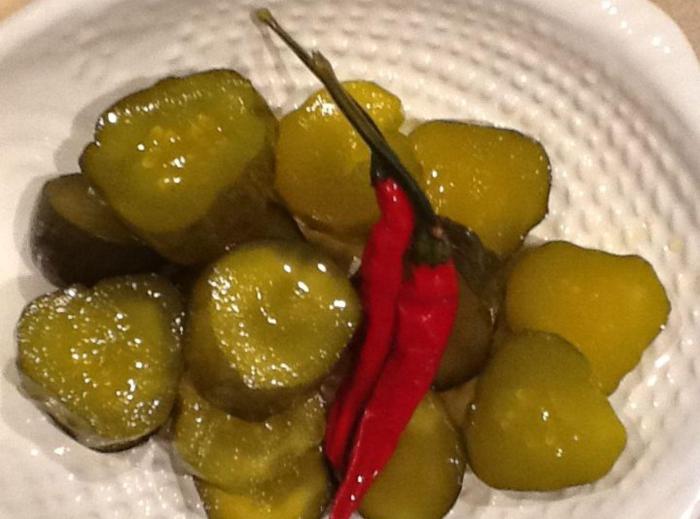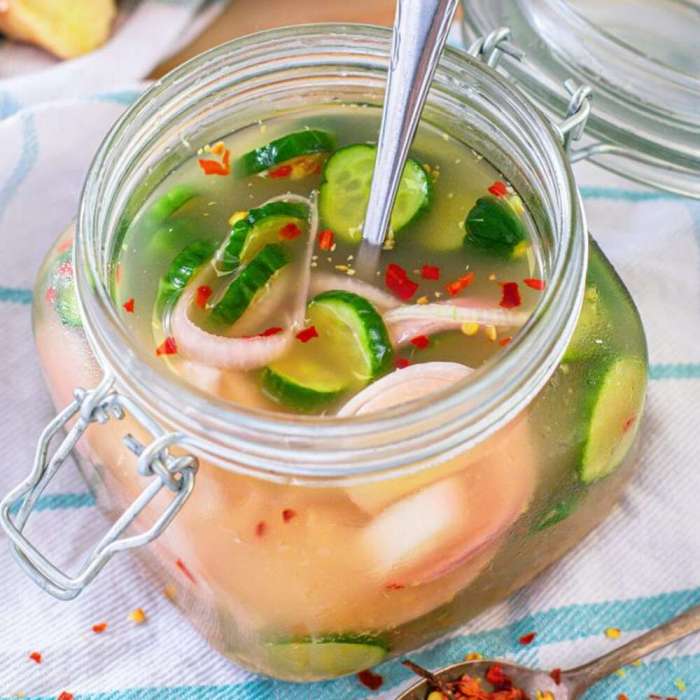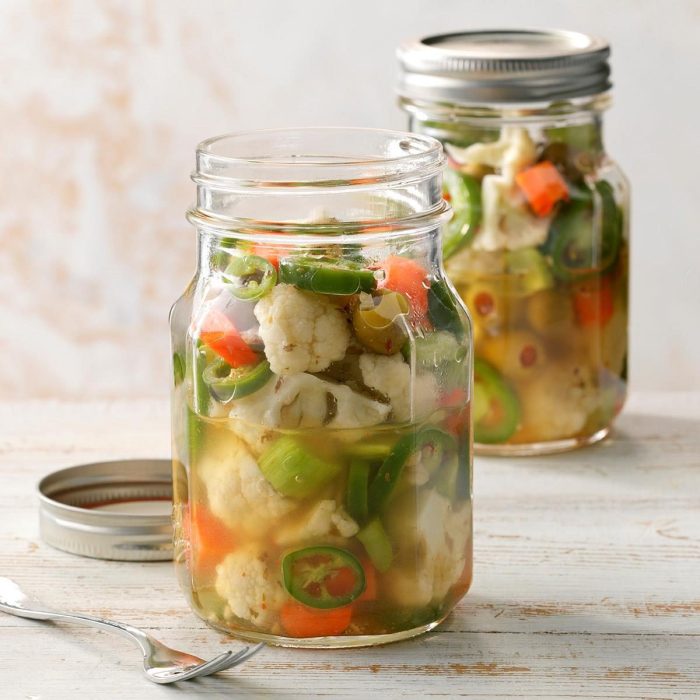Spicy pickle recipe – the words alone conjure images of crisp, tangy, and intensely flavorful pickles. These culinary gems are more than just a side dish; they’re a versatile ingredient that can elevate any meal, from a simple sandwich to a gourmet appetizer.
From the fiery heat of Korean gochujang pickles to the refreshing tang of Indian achaar, the world of spicy pickles is a delicious and diverse one.
This guide will delve into the fascinating world of spicy pickles, exploring their history, the essential ingredients that make them unique, and various techniques for crafting your own perfect batch. We’ll uncover the secrets of spice blends, provide expert tips for achieving the perfect crunch and level of heat, and inspire you with creative ways to serve and enjoy these culinary delights.
Introduction to Spicy Pickles

Spicy pickles are a culinary delight that has captivated taste buds worldwide for centuries. Their tangy, crunchy texture, coupled with a fiery kick, adds a unique dimension to various dishes and snacks. The appeal of spicy pickles lies in their versatility, as they can be enjoyed as a standalone snack, a condiment for sandwiches and burgers, or an ingredient in salads and other culinary creations.The allure of spicy pickles extends beyond their taste.
They are a source of probiotics, which are beneficial bacteria that promote gut health. The fermentation process involved in pickle making also preserves nutrients and enhances their flavor profile.
Popular Spicy Pickle Variations Worldwide
Spicy pickle variations are diverse and reflect the culinary traditions of different regions. Some popular examples include:
- Indian Spicy Pickles:These pickles are often made with a blend of spices like mustard seeds, chili peppers, and turmeric, resulting in a fiery and aromatic flavor.
- Korean Spicy Pickles:Known as “Kimchi,” these pickles are fermented with a variety of spices, including gochugaru (Korean chili pepper flakes), garlic, and ginger, creating a complex and spicy flavor profile.
- American Spicy Pickles:These pickles are typically made with cucumbers, vinegar, and a combination of spices like chili peppers, garlic, and black peppercorns. The level of spiciness can vary depending on the type and quantity of chili peppers used.
History of Spicy Pickle Making
The art of pickle making dates back to ancient civilizations. Evidence suggests that pickles have been enjoyed for over 4,000 years, with early methods involving salting and fermenting vegetables to preserve them.
The first documented use of spices in pickle making dates back to ancient India, where spices like turmeric, chili peppers, and mustard seeds were used to enhance the flavor and preserve the pickles.
Spicy pickles gained popularity in Europe during the Middle Ages, as spices were introduced from the East. The use of chili peppers in pickle making became more widespread in the Americas after the discovery of the New World.Today, spicy pickles are enjoyed by people worldwide, with countless variations and recipes passed down through generations.
Their enduring appeal is a testament to their unique flavor profile and versatility in culinary applications.
Spicy Pickle Techniques

There are several methods for preparing spicy pickles, each offering distinct flavor profiles, shelf life, and preparation times. The most common methods are quick pickles, fermented pickles, and refrigerator pickles.
Pickle Preparation Methods
The choice of method depends on your desired flavor, time constraints, and storage preferences. Each method involves specific steps and techniques, which are summarized in the following table:
| Method | Preparation Time | Shelf Life | Flavor Characteristics |
|---|---|---|---|
| Quick Pickles | 1-2 days | 1-2 weeks in the refrigerator | Crisp, bright, and tangy with a quick vinegar infusion. |
| Fermented Pickles | 1-4 weeks | Months to years in a cool, dark place | Complex, sour, and tangy with a unique depth of flavor due to lactic acid fermentation. |
| Refrigerator Pickles | 1-2 days | 2-3 weeks in the refrigerator | Mild, refreshing, and slightly tangy, with a shorter shelf life due to the absence of fermentation. |
Quick Pickles
Quick pickles are a fast and easy way to enjoy spicy pickles. They involve submerging vegetables in a brine solution of vinegar, sugar, salt, and spices. The quick pickling process doesn’t involve fermentation, so the pickles retain their crisp texture and bright flavor.
Learn about more about the process of taco ring recipe in the field.
Steps for Making Quick Pickles
- Prepare the vegetables: Wash and cut the vegetables into desired shapes. For spicy pickles, you can use cucumbers, carrots, onions, peppers, or other vegetables.
- Create the brine solution: Combine vinegar, sugar, salt, and spices in a saucepan. Heat the mixture until the sugar and salt dissolve. Let it cool completely before using.
- Pack the vegetables: Place the prepared vegetables in sterilized jars, leaving some space at the top.
- Pour the brine: Pour the cooled brine over the vegetables, ensuring they are completely submerged.
- Seal and store: Seal the jars tightly and refrigerate for at least 24 hours before serving. Quick pickles can be stored in the refrigerator for up to 2 weeks.
Fermented Pickles
Fermented pickles are a traditional method of preserving vegetables. They involve submerging vegetables in a salt brine and allowing naturally occurring bacteria to ferment the vegetables, creating a unique and complex flavor profile.
Steps for Making Fermented Pickles
- Prepare the vegetables: Wash and cut the vegetables into desired shapes. For spicy pickles, you can use cucumbers, carrots, onions, peppers, or other vegetables.
- Create the salt brine: Dissolve salt in water, using a ratio of about 2-3% salt by weight. For example, for 1 kg of vegetables, use 20-30 grams of salt.
- Pack the vegetables: Place the prepared vegetables in a sterilized jar or crock, leaving some space at the top.
- Pour the brine: Pour the salt brine over the vegetables, ensuring they are completely submerged. Place a weight on top of the vegetables to keep them submerged.
- Ferment: Cover the jar or crock with a cloth or cheesecloth and allow the vegetables to ferment at room temperature for 1-4 weeks, depending on the desired flavor intensity. During fermentation, bubbles will form as the bacteria break down the sugars in the vegetables.
- Store: Once the desired fermentation level is reached, transfer the fermented pickles to the refrigerator to slow down the fermentation process. Fermented pickles can be stored in the refrigerator for months or even years.
Refrigerator Pickles
Refrigerator pickles are a simple and quick way to enjoy spicy pickles without the need for fermentation. They are made by submerging vegetables in a vinegar-based brine and storing them in the refrigerator.
Steps for Making Refrigerator Pickles
- Prepare the vegetables: Wash and cut the vegetables into desired shapes. For spicy pickles, you can use cucumbers, carrots, onions, peppers, or other vegetables.
- Create the brine solution: Combine vinegar, sugar, salt, and spices in a saucepan. Heat the mixture until the sugar and salt dissolve. Let it cool completely before using.
- Pack the vegetables: Place the prepared vegetables in sterilized jars, leaving some space at the top.
- Pour the brine: Pour the cooled brine over the vegetables, ensuring they are completely submerged.
- Seal and store: Seal the jars tightly and refrigerate for at least 24 hours before serving. Refrigerator pickles can be stored in the refrigerator for up to 2-3 weeks.
Spice Blends for Spicy Pickles

The right spice blend can transform your pickles from ordinary to extraordinary. The key is to find a balance of flavors that complement the cucumber and vinegar. Whether you prefer a fiery kick or a subtle warmth, there’s a spice blend for every palate.
Common Spice Combinations
Spice blends for spicy pickles typically include a combination of:
- Chilli peppers:From mild jalapeños to fiery habaneros, chilli peppers add heat and complexity to your pickles.
- Black peppercorns:These provide a pungent, earthy flavor that enhances the overall taste.
- Garlic:Garlic adds a savory, pungent flavor and complements the chilli peppers.
- Ginger:Ginger provides a warm, slightly sweet flavor that balances the heat.
- Mustard seeds:Mustard seeds offer a sharp, tangy flavor that complements the vinegar.
- Cumin:Cumin adds a warm, earthy flavor that works well with chilli peppers and garlic.
- Other spices:Other spices, such as coriander seeds, allspice, or cloves, can be used to add depth and complexity to the flavor profile.
Spice Blends and Their Flavor Profiles
Here is a table showcasing different spice blends, their flavor profiles, and recommended cucumber varieties:
| Spice Blend | Flavor Profile | Recommended Cucumber Variety |
|---|---|---|
| Jalapeño, Black Pepper, Garlic | Spicy, Savory, Earthy | Persian Cucumber |
| Habanero, Ginger, Mustard Seed | Fiery, Sweet, Tangy | English Cucumber |
| Serrano, Cumin, Coriander Seed | Spicy, Earthy, Aromatic | Kirby Cucumber |
| Cayenne, Allspice, Cloves | Warm, Spicy, Sweet | Japanese Cucumber |
Spicy Pickle Recipe with a Unique Spice Blend
This recipe features a unique blend of spices that creates a complex and flavorful pickle:
Spicy Mango Pickle
This recipe features a unique blend of spices that creates a complex and flavorful pickle:
Ingredients:
- 1 pound Kirby cucumbers, sliced
- 1 cup white vinegar
- 1/2 cup water
- 1/4 cup sugar
- 1 tablespoon salt
- 1/2 teaspoon black peppercorns
- 1/4 teaspoon red pepper flakes
- 1/4 teaspoon ground ginger
- 1/4 teaspoon ground turmeric
- 1/4 teaspoon ground cumin
- 1/4 cup chopped mango
Instructions:
- In a large saucepan, combine the vinegar, water, sugar, salt, peppercorns, red pepper flakes, ginger, turmeric, and cumin. Bring to a boil over medium heat, stirring until the sugar and salt dissolve.
- Reduce heat to low and simmer for 5 minutes. Remove from heat and let cool slightly.
- Pack the cucumber slices into clean jars. Pour the cooled brine over the cucumbers, leaving about 1/2 inch of headspace. Add the chopped mango to the jars.
- Seal the jars tightly and refrigerate for at least 24 hours before serving.
This recipe features a unique blend of spices that creates a complex and flavorful pickle. The mango adds a touch of sweetness and fruitiness that balances the spice. The ginger and turmeric provide a warm, earthy flavor that complements the mango and cucumbers.
The black peppercorns and red pepper flakes add a subtle heat that builds over time. This pickle is perfect for enjoying on its own or as a topping for sandwiches, burgers, or salads.
Tips for Perfect Spicy Pickles
Crafting the perfect spicy pickle requires a blend of technique and attention to detail. From selecting the freshest cucumbers to mastering the art of spice blending, there are several key factors that contribute to a truly exceptional pickle.
Achieving the Desired Level of Spiciness
The level of spiciness in your pickles is entirely customizable. To achieve the desired heat, consider the type of chili peppers you use.
- Mild Peppers:For a gentle kick, opt for peppers like Anaheim or Poblano. These peppers provide a subtle heat without overwhelming the flavor of the pickle.
- Medium Peppers:For a more noticeable heat, try Jalapeño or Serrano peppers. These peppers offer a balanced heat that adds complexity to the pickle.
- Hot Peppers:For those who prefer a fiery bite, consider Habanero or Ghost Pepper. These peppers deliver intense heat and should be used sparingly.
Remember, the heat of peppers can vary depending on the season and growing conditions. It’s always a good idea to start with a smaller amount of spice and adjust according to your taste preferences.
Maintaining a Crisp Texture, Spicy pickle recipe
The crunch of a pickle is just as important as its flavor. To ensure your pickles retain their crispness, it’s crucial to select fresh, firm cucumbers.
- Cucumber Selection:Choose cucumbers that are free of blemishes and have a firm, springy texture. Avoid cucumbers that are soft or wrinkled, as these will likely become mushy during the pickling process.
- Brine Ratio:The brine ratio is crucial for maintaining the pickle’s crunch. A higher ratio of vinegar to water will result in a crispier pickle. Experiment with different ratios to find the perfect balance for your preference.
- Pickling Time:The length of time the pickles spend in the brine also affects their texture. For a crispier pickle, reduce the pickling time. Longer pickling times can lead to a softer texture.
Choosing the Right Spices
The spice blend you use will greatly influence the overall flavor profile of your pickles. Experiment with different combinations to find your perfect blend.
- Traditional Spices:Classic pickling spices like black peppercorns, mustard seeds, and coriander seeds offer a balanced flavor profile that complements the cucumber.
- Flavor Enhancers:Adding spices like garlic, ginger, or onion can add depth and complexity to the flavor of the pickle.
- Heat Boosters:For a spicy kick, include chili flakes, cayenne pepper, or other chili peppers. Remember to adjust the amount based on your desired level of heat.
Serving and Enjoying Spicy Pickles
Spicy pickles are not just a delicious snack; they add a burst of flavor and heat to a variety of dishes. Their versatility extends far beyond the traditional sandwich or burger. From simple additions to elaborate culinary creations, spicy pickles offer a unique and satisfying taste experience.
Creative Culinary Applications
Spicy pickles can be incorporated into a wide range of culinary creations, adding a tangy kick and vibrant color to your dishes. Here are a few ideas:
- Spicy Pickle Pizza:Imagine a pizza topped with spicy pickle slices, crumbled feta cheese, and a drizzle of honey. The sweet and savory combination creates a truly unique flavor profile.
- Spicy Pickle Relish:A spicy pickle relish can be used as a topping for hot dogs, burgers, and sandwiches. Its vibrant color and spicy kick add a burst of flavor to any dish.
- Spicy Pickle Coleslaw:A crunchy and spicy coleslaw made with spicy pickles can be served alongside grilled meats or fish. The tangy and spicy flavors complement the richness of the meat.
- Spicy Pickle Soup:Spicy pickles can be added to soups and stews for a tangy and spicy twist. They can be chopped and added during the cooking process or served as a garnish.
Storing Spicy Pickles
To maintain the freshness and flavor of your spicy pickles, it’s crucial to store them properly. Here are some tips:
- Refrigerate:Spicy pickles should be stored in the refrigerator to prevent spoilage. The ideal temperature is between 35°F and 40°F (1.5°C and 4.5°C).
- Airtight Container:Store your pickles in an airtight container to prevent them from drying out and absorbing other flavors in the refrigerator.
- Avoid Freezing:Freezing pickles can affect their texture and flavor. It’s best to avoid freezing them.
- Shelf Life:Properly stored spicy pickles can last for several weeks in the refrigerator.
Wrap-Up: Spicy Pickle Recipe
As you embark on your spicy pickle journey, remember that the key to success lies in experimentation. Don’t be afraid to adjust the recipe to your taste preferences, trying different spice combinations and vinegar types. With a little creativity and a dash of adventurous spirit, you can craft spicy pickles that are uniquely your own.
So, grab your cucumbers, spices, and vinegar, and let’s create some culinary magic together!
